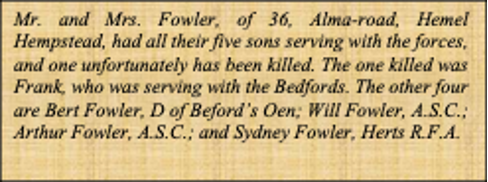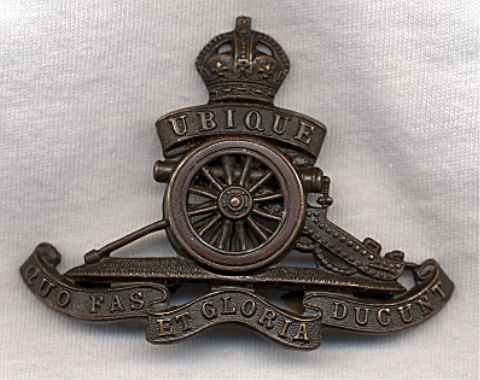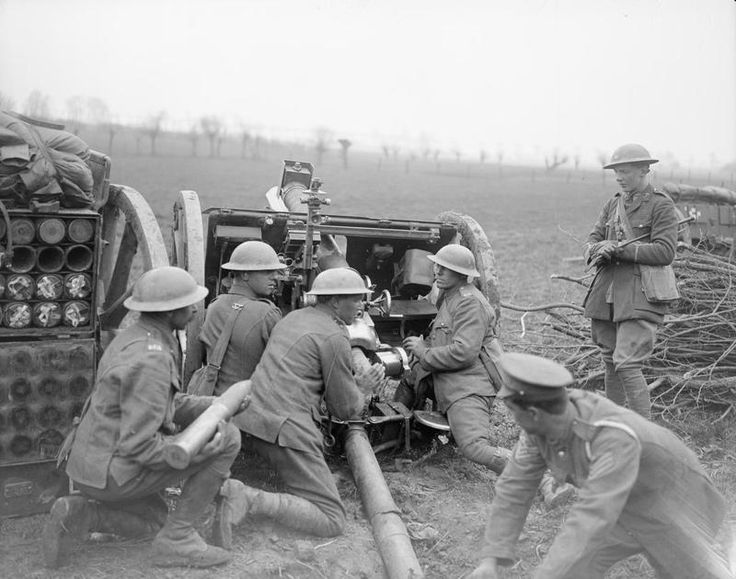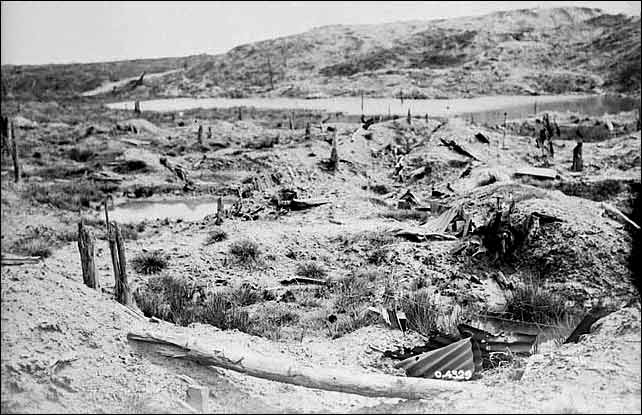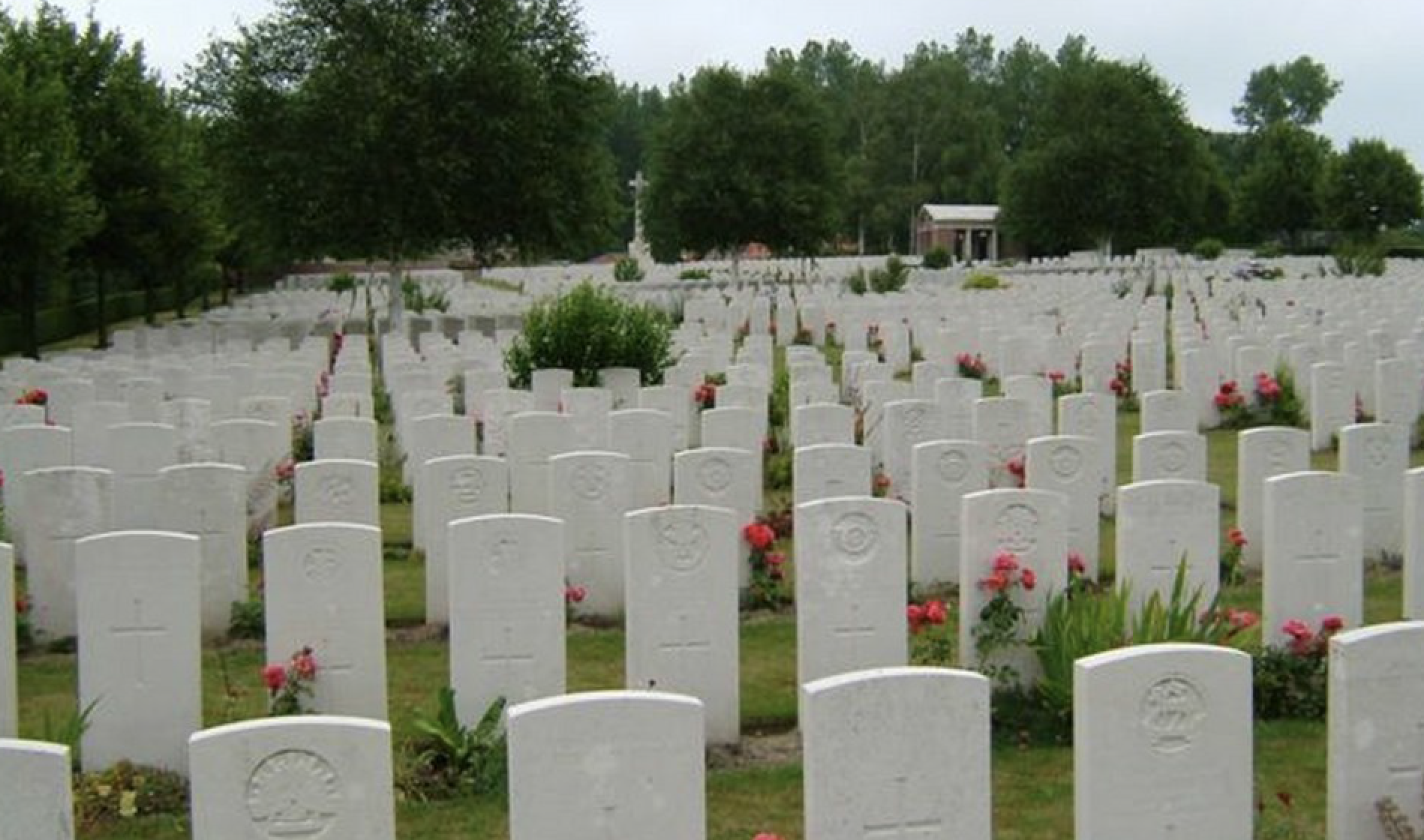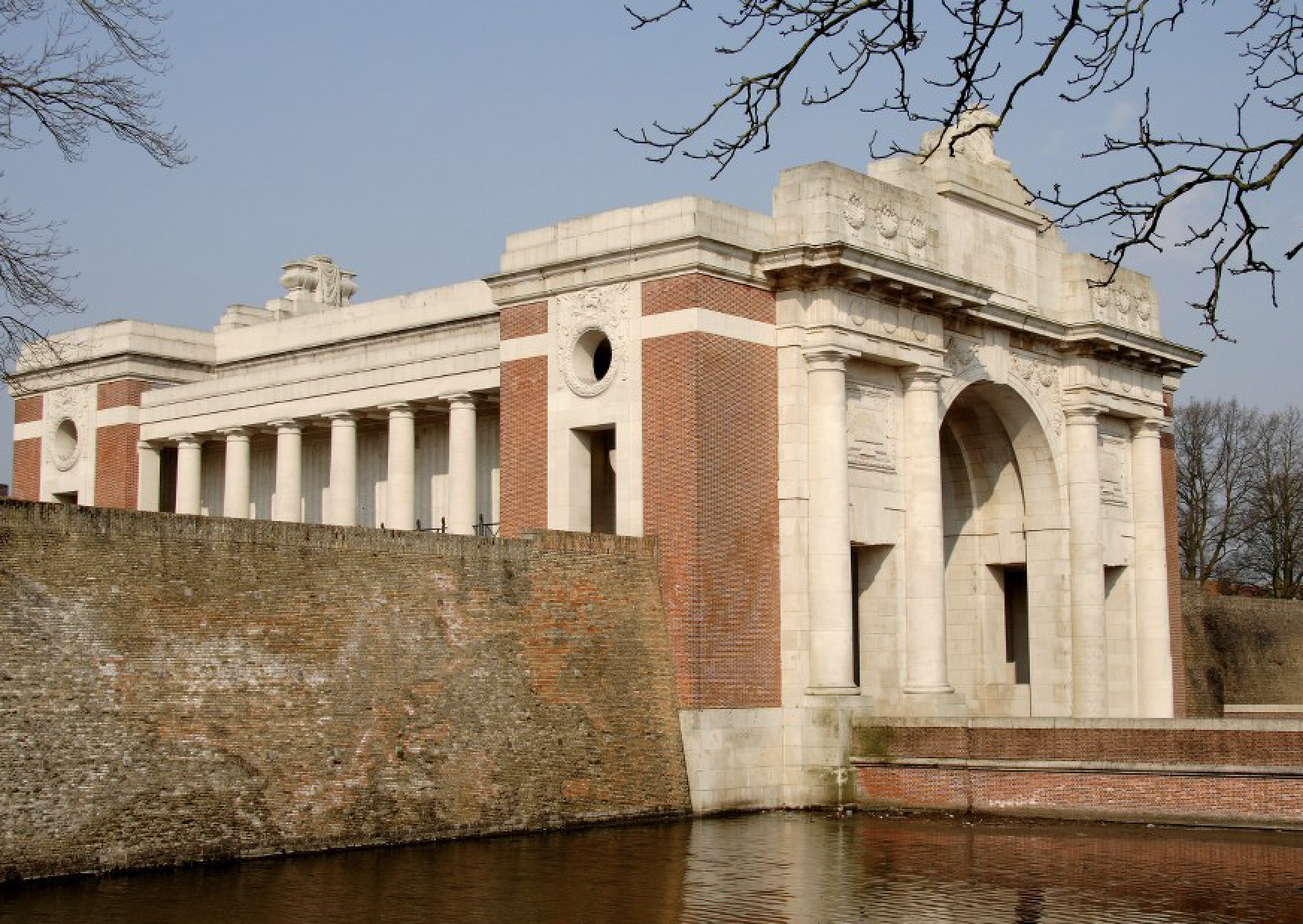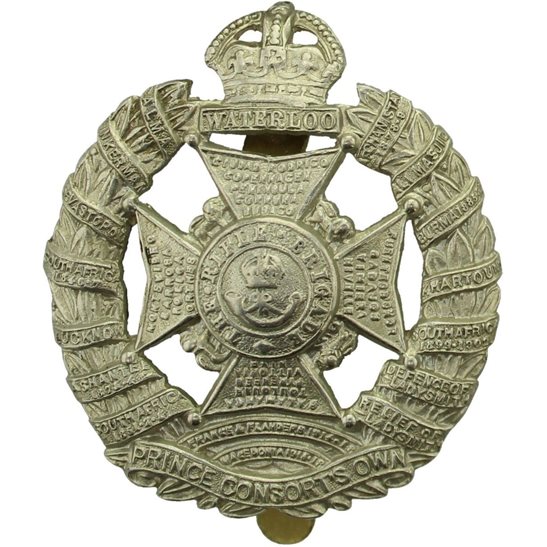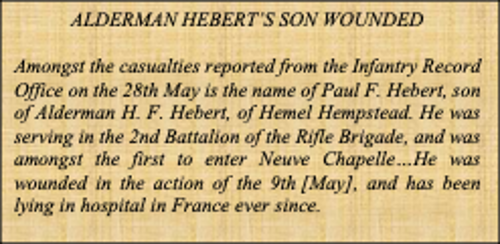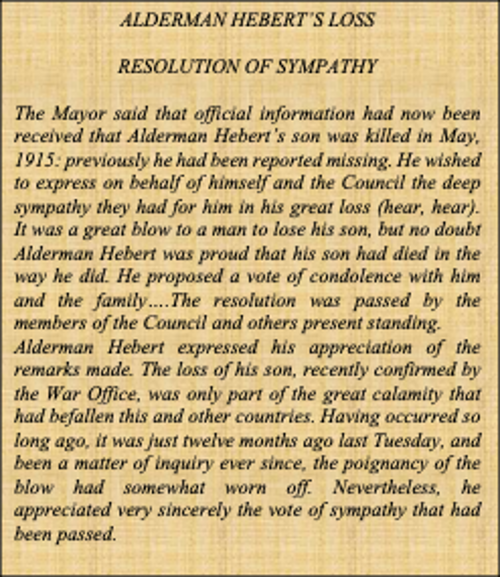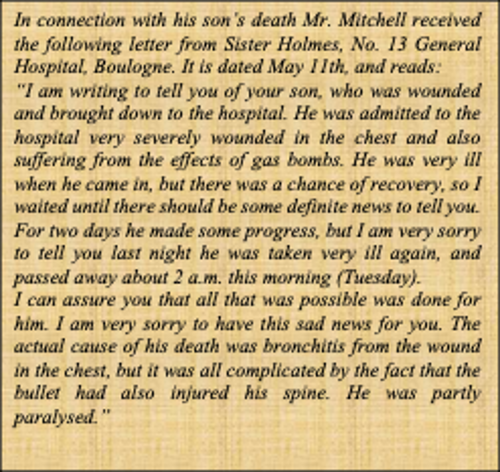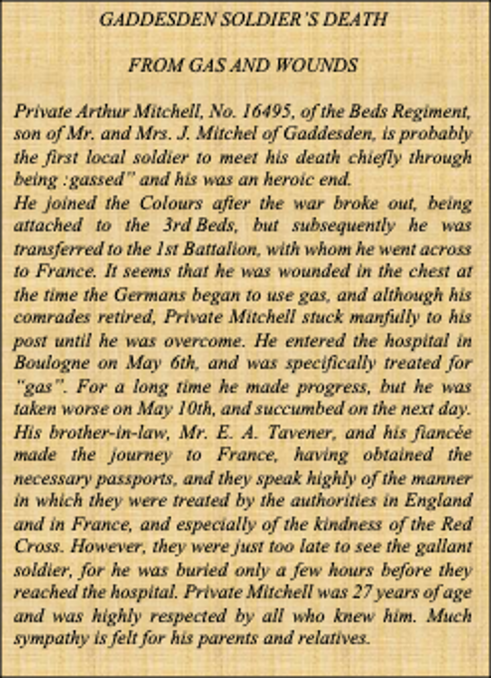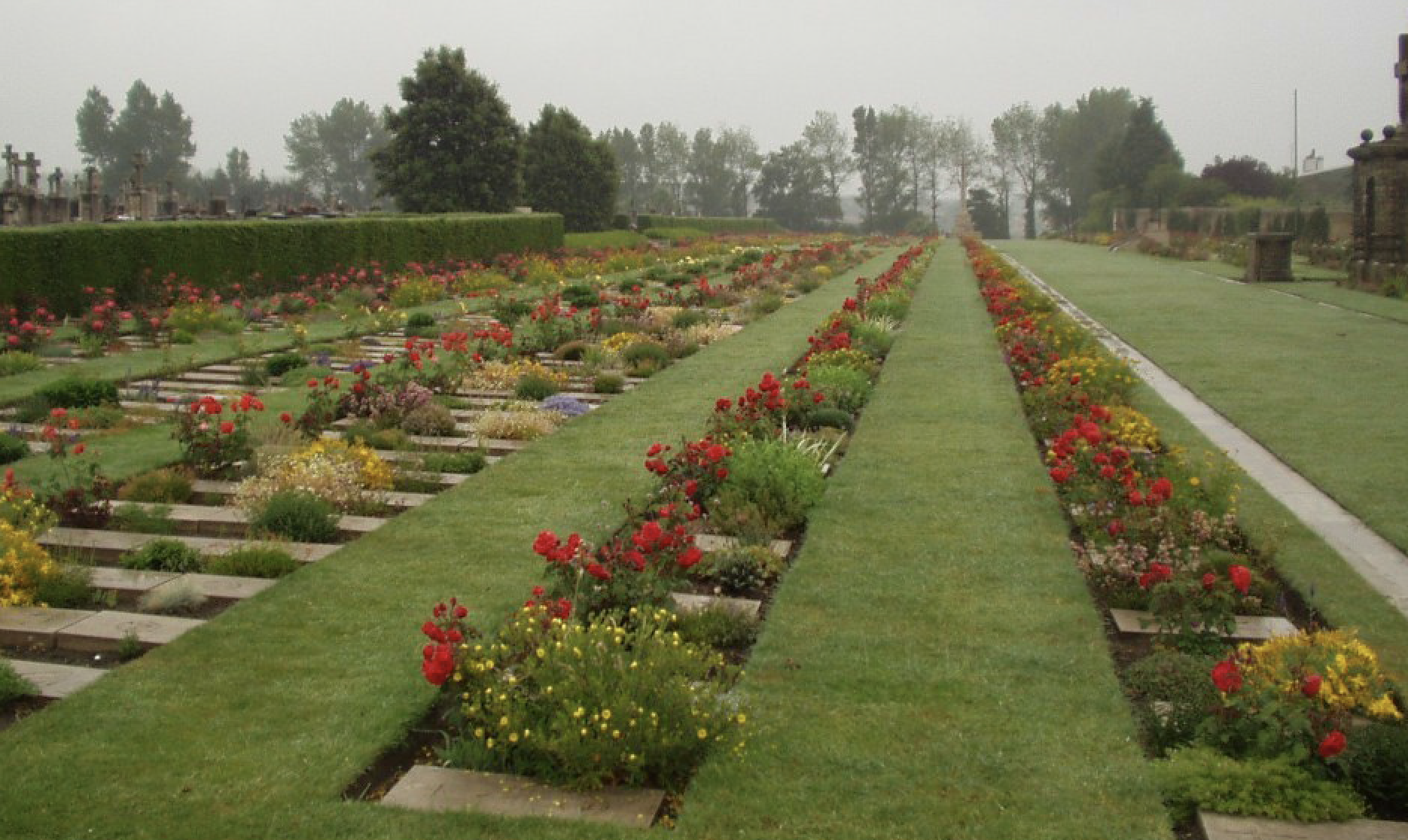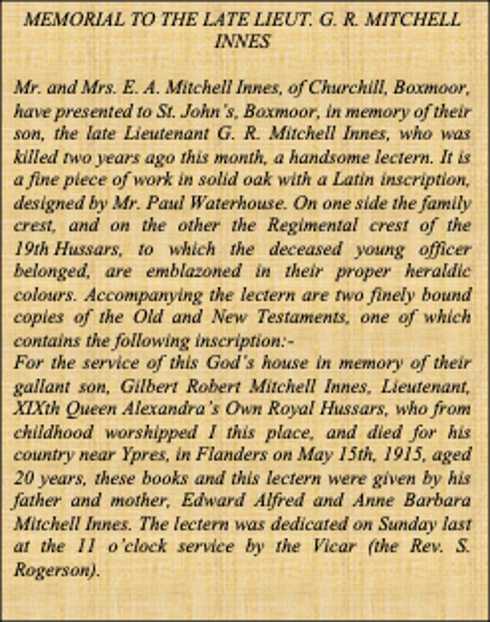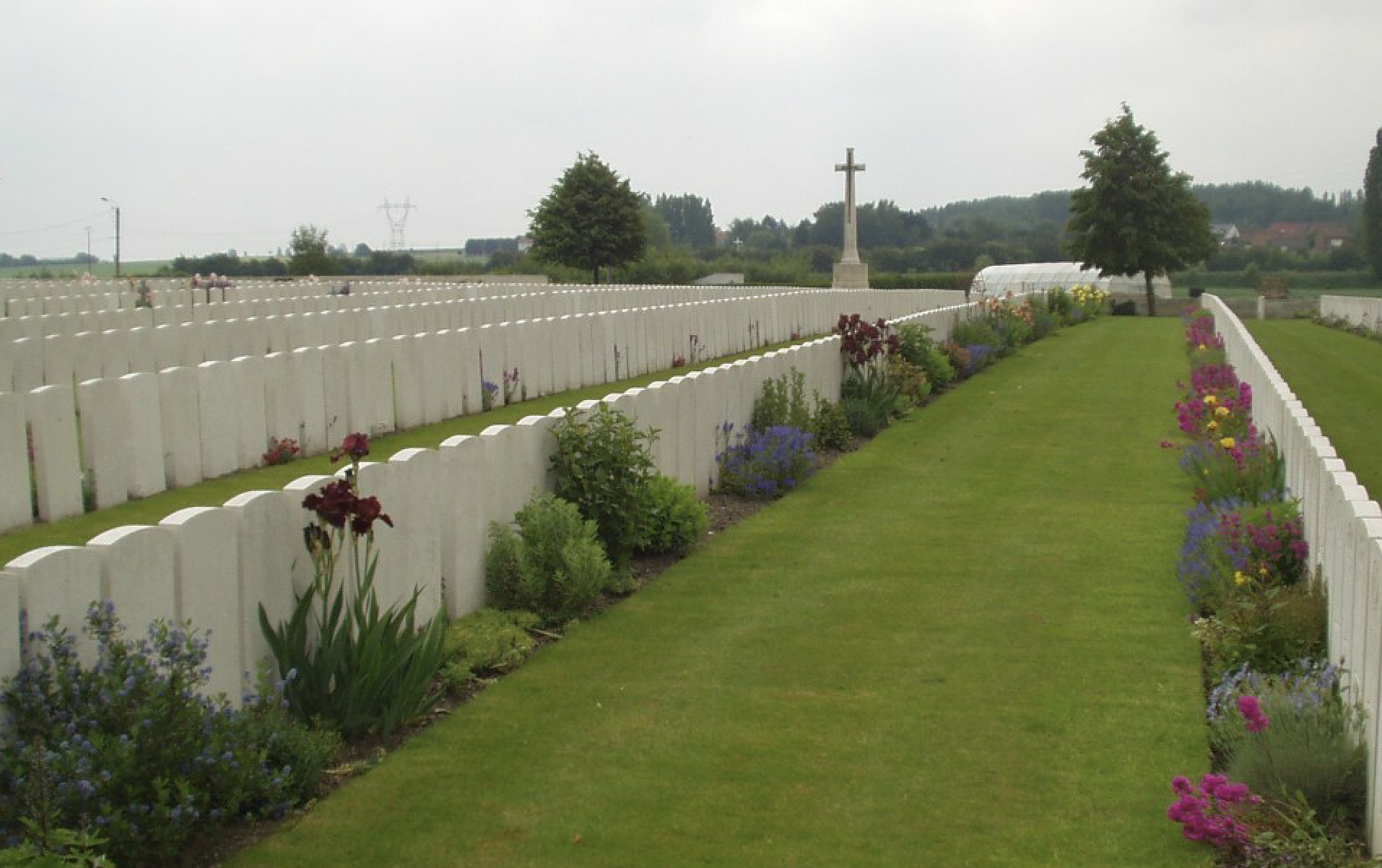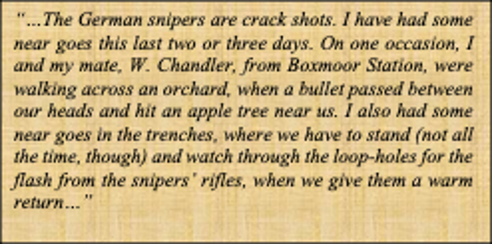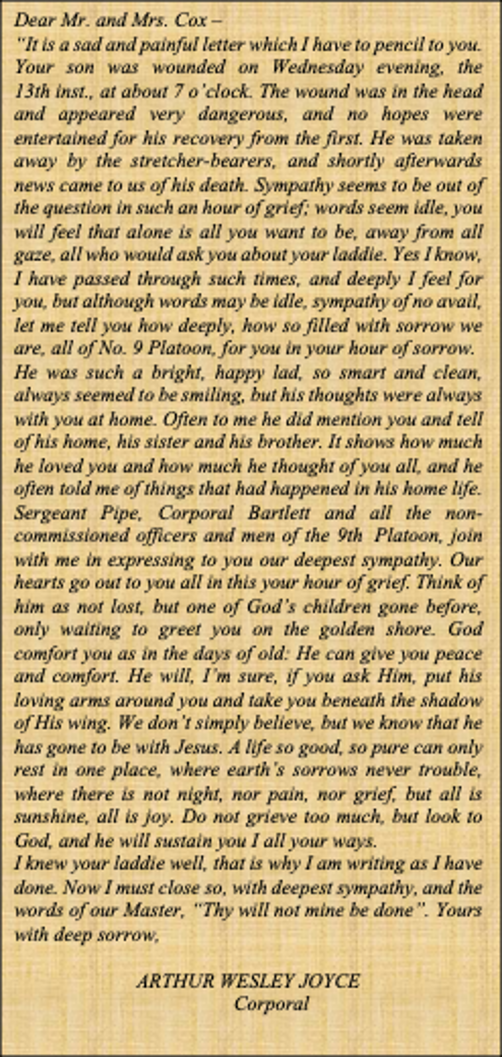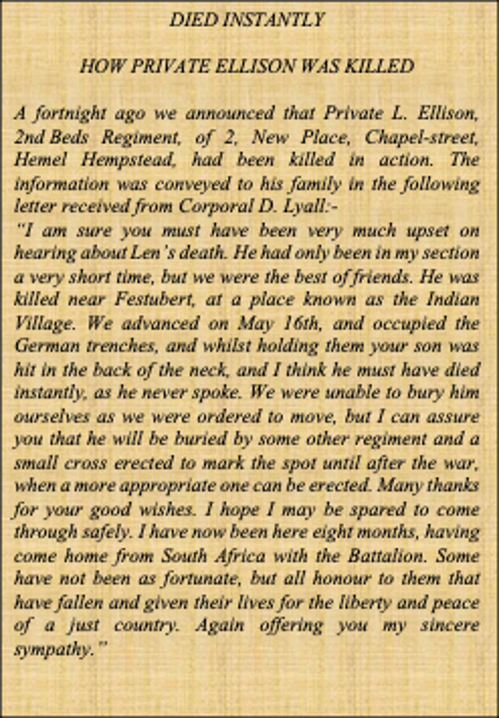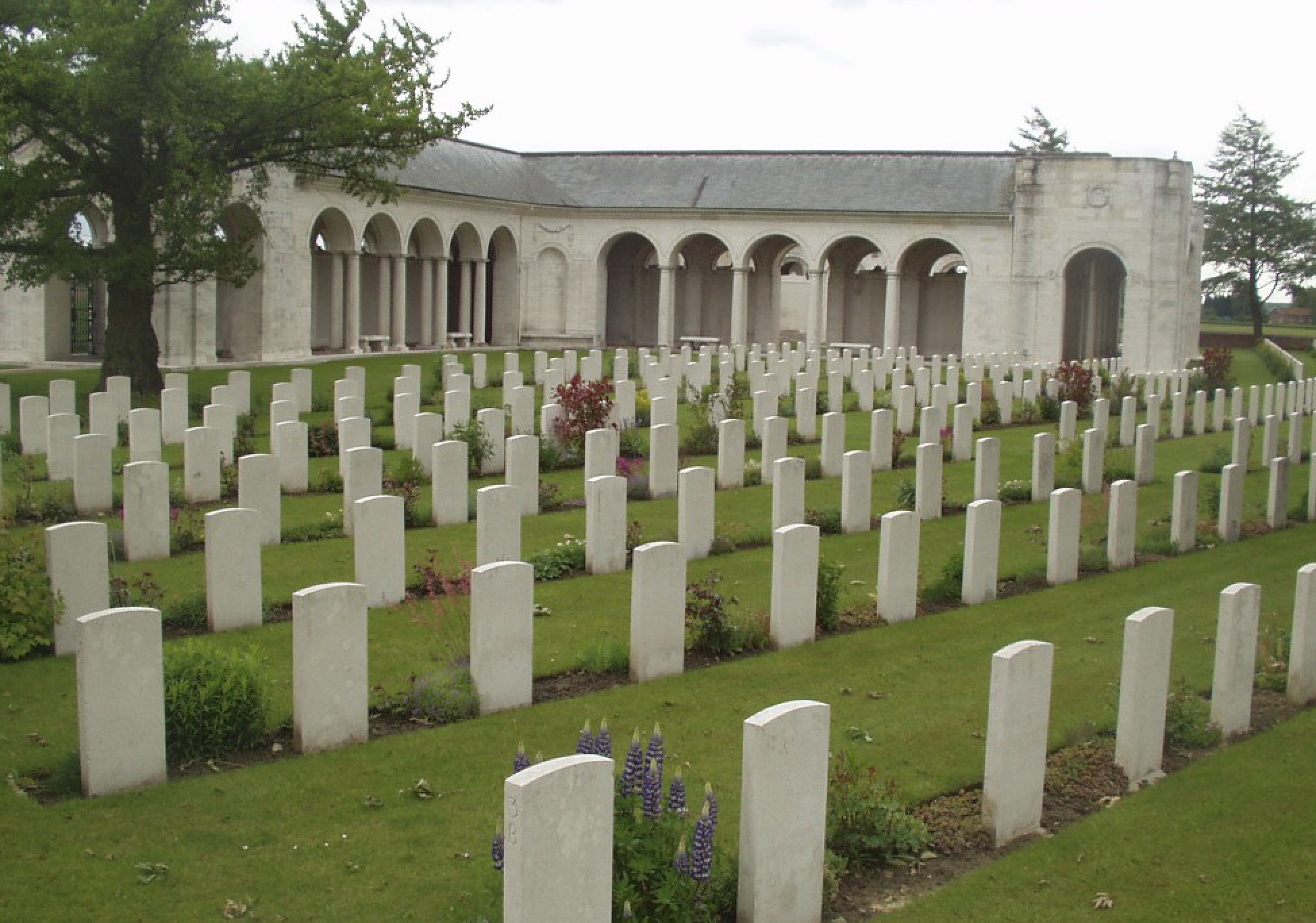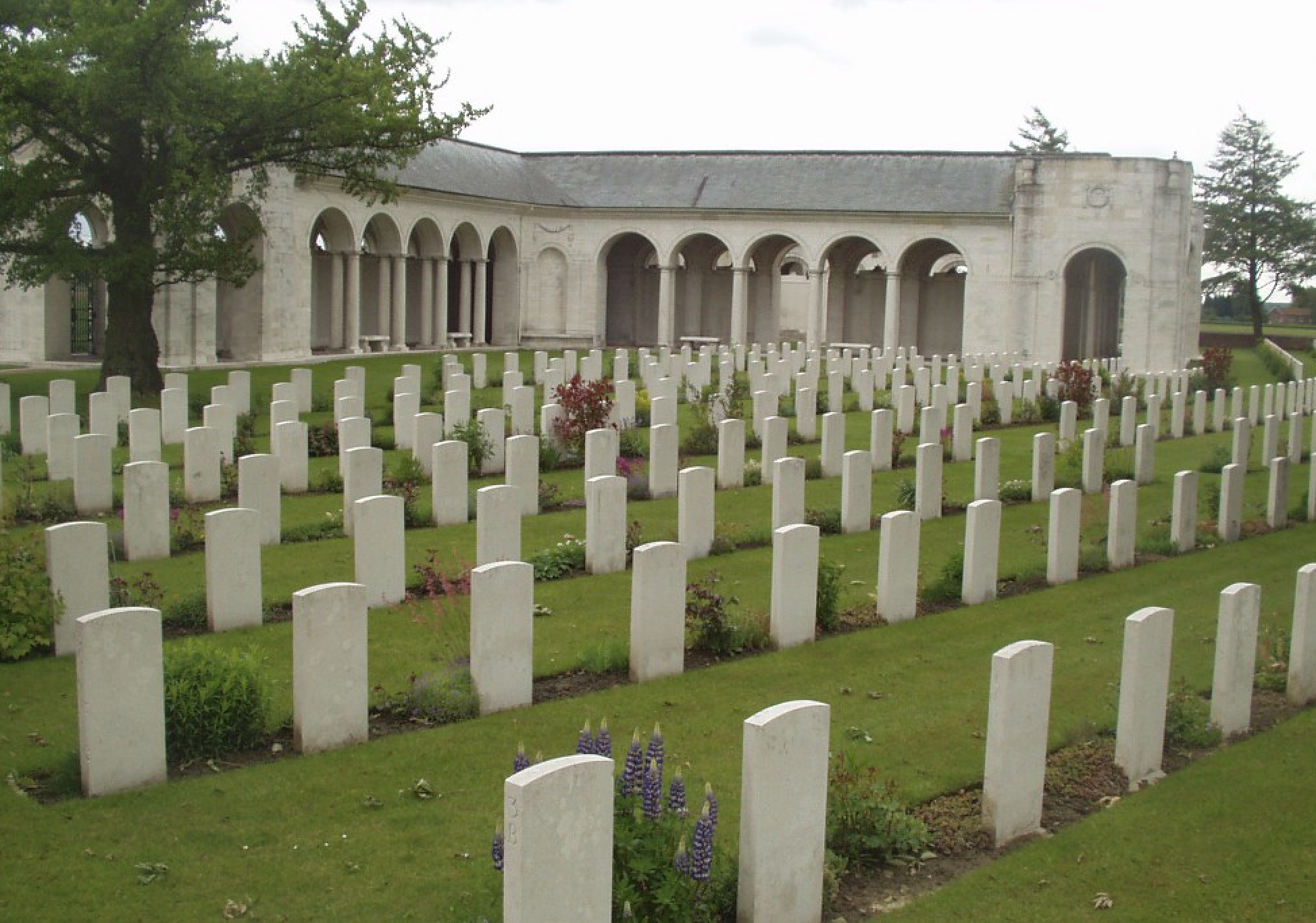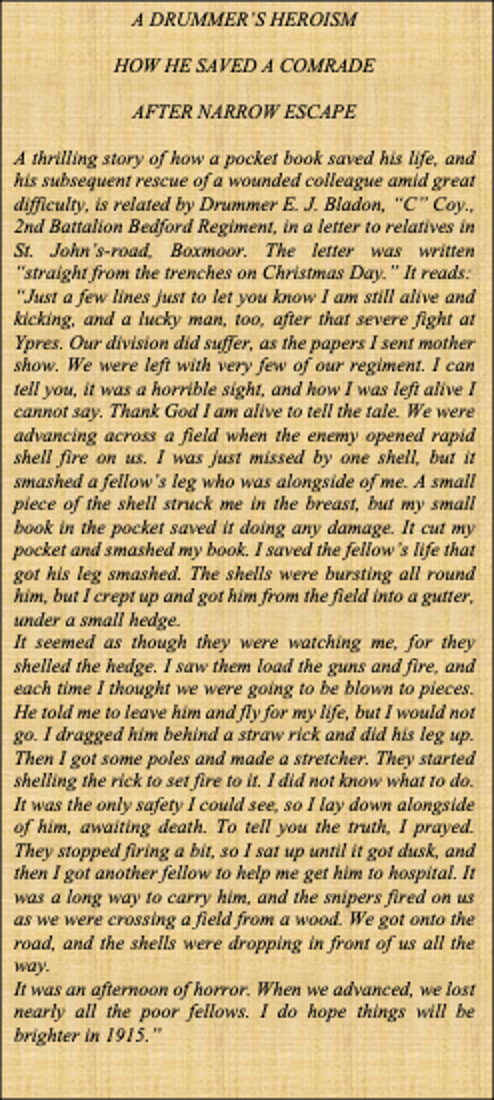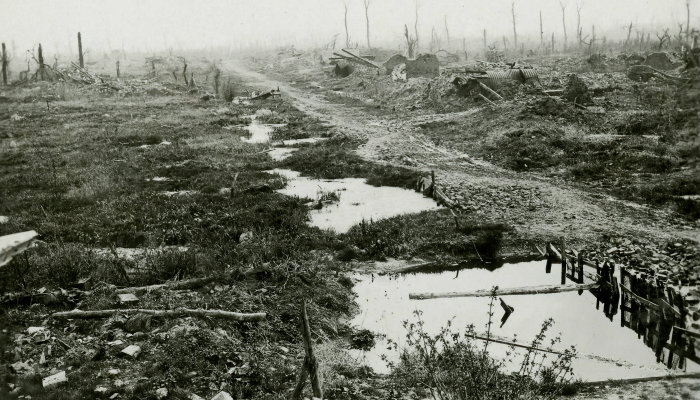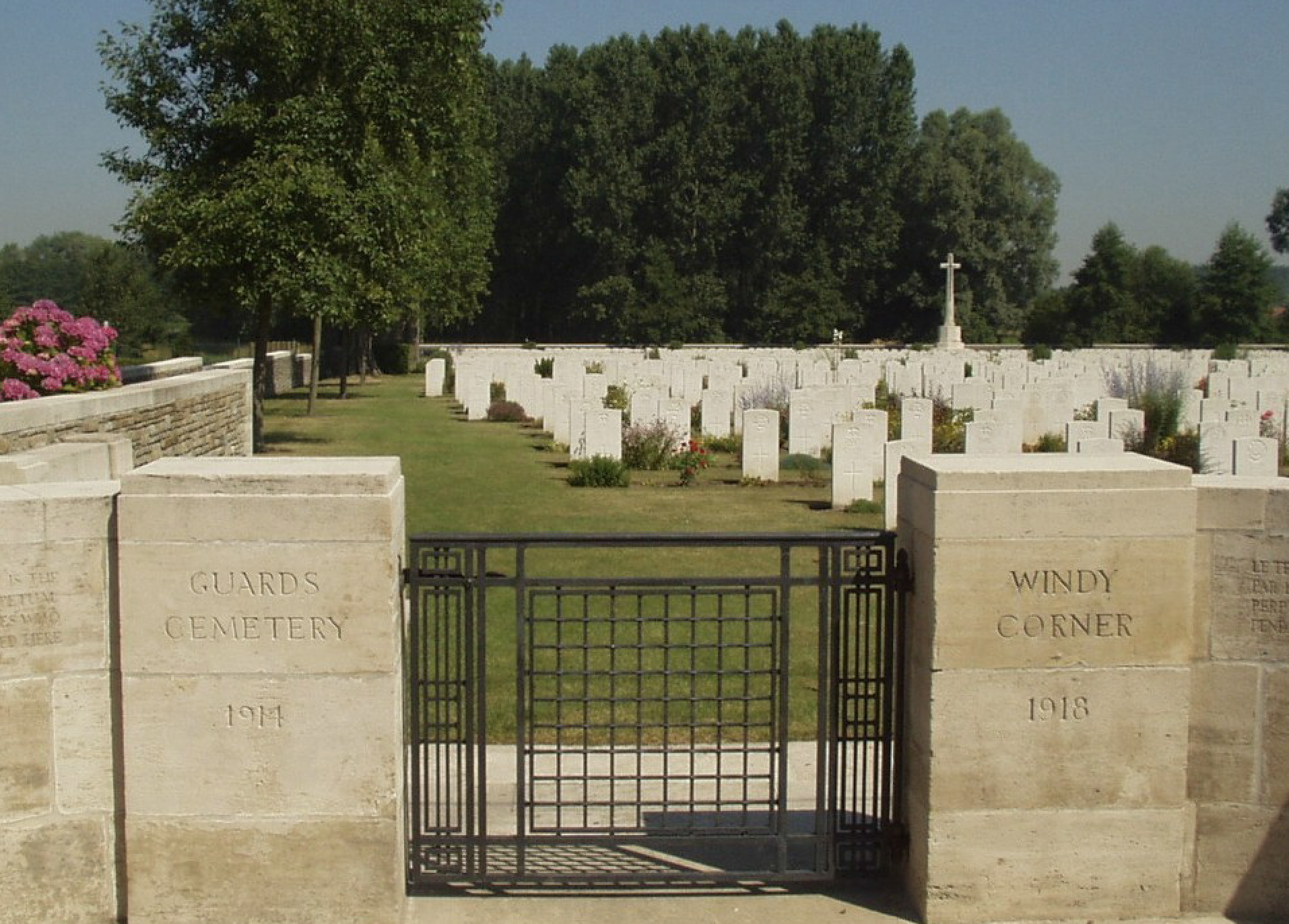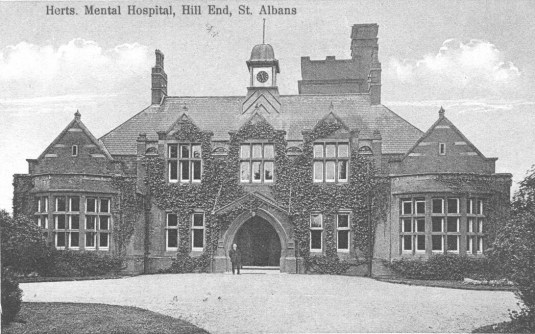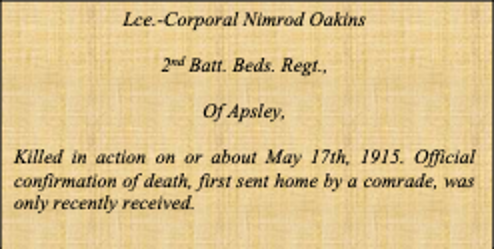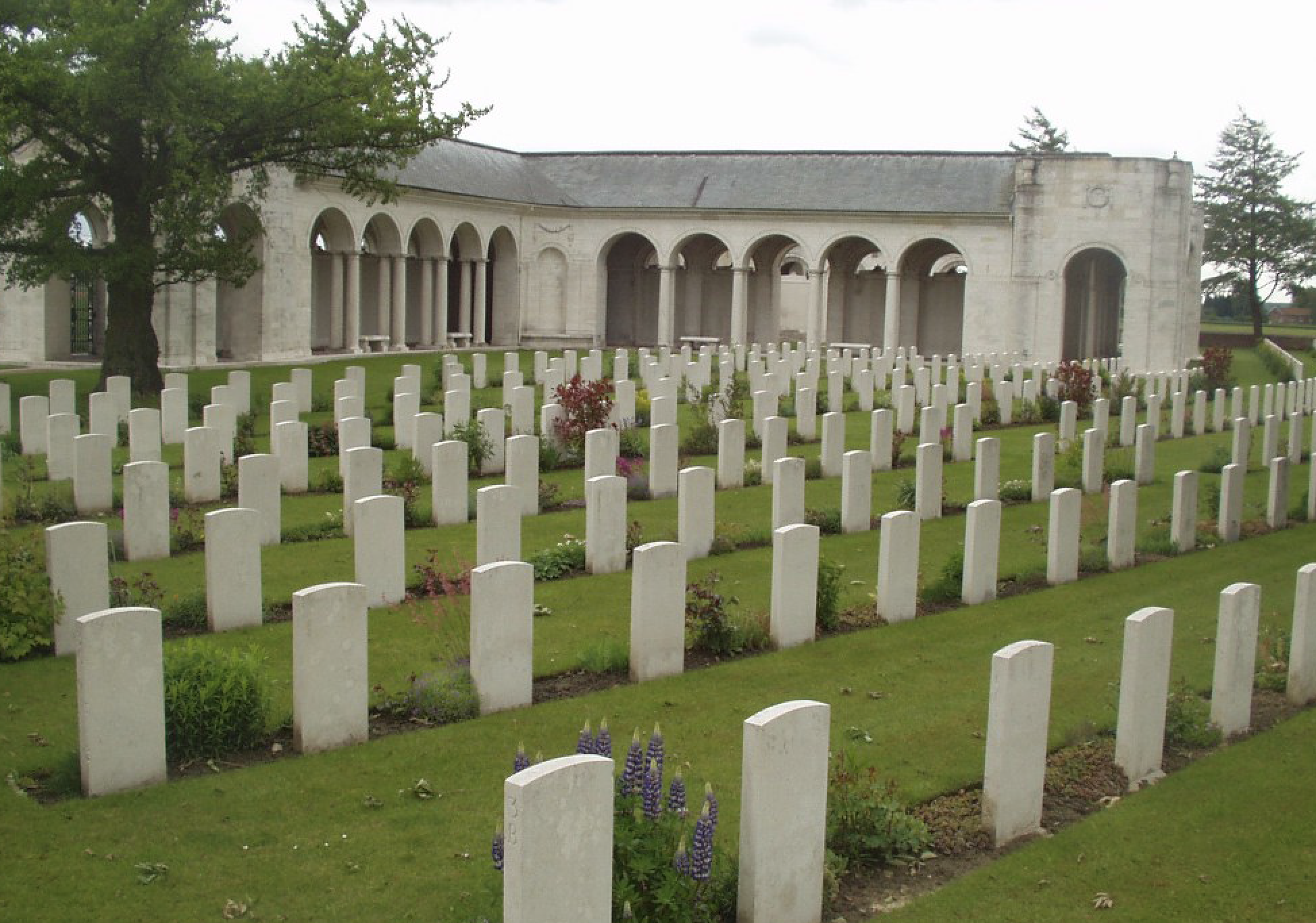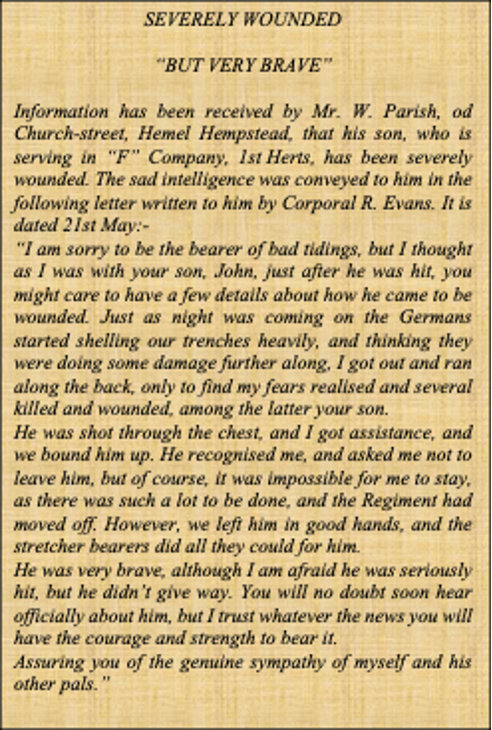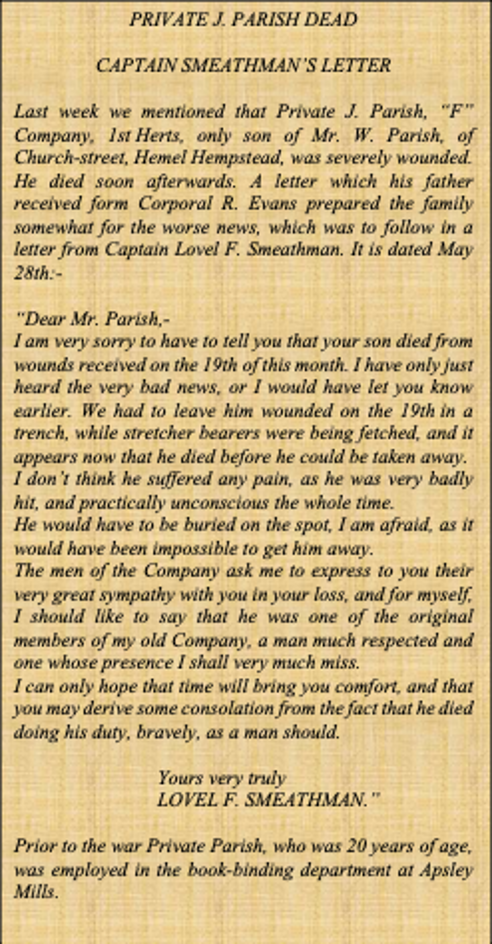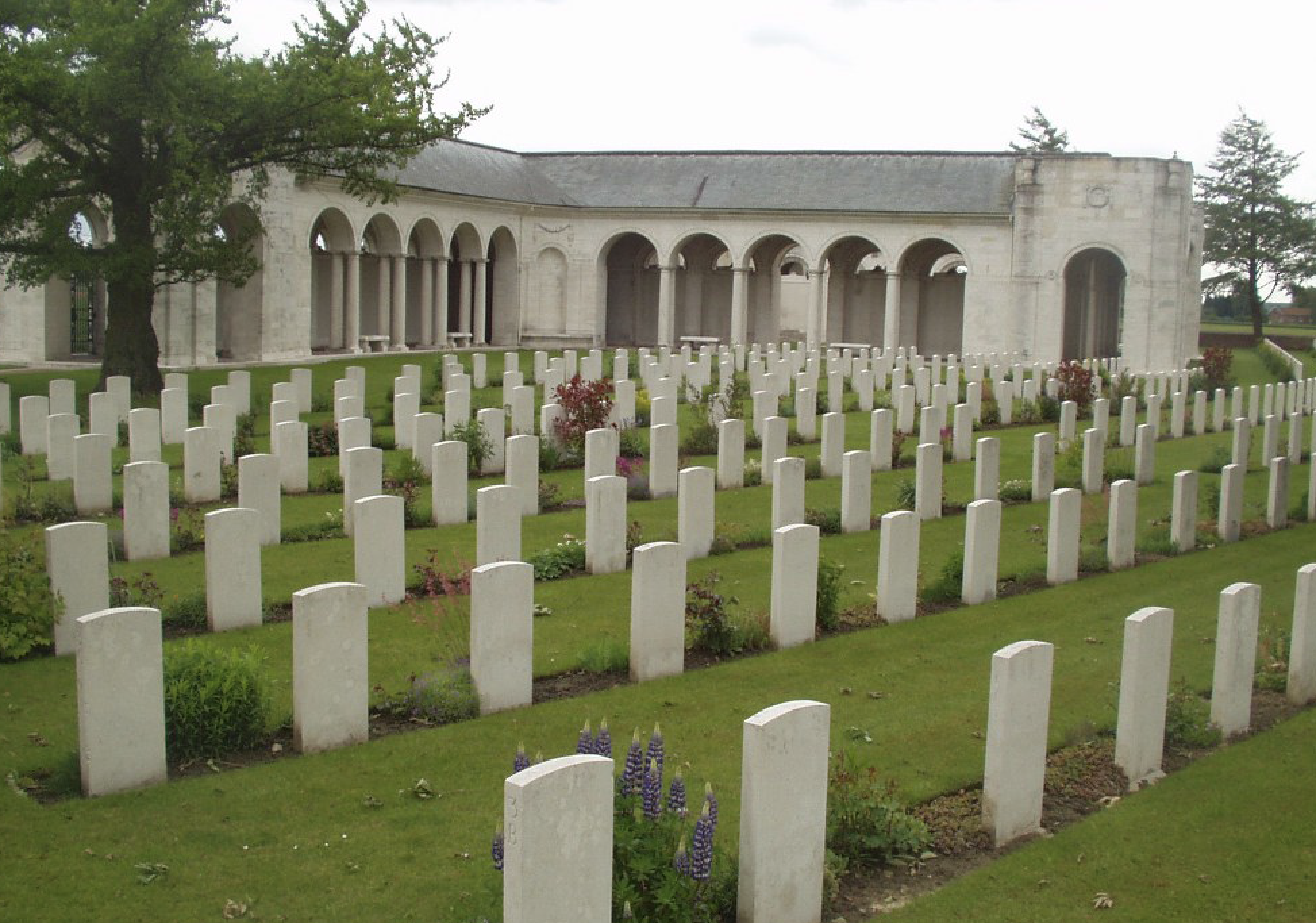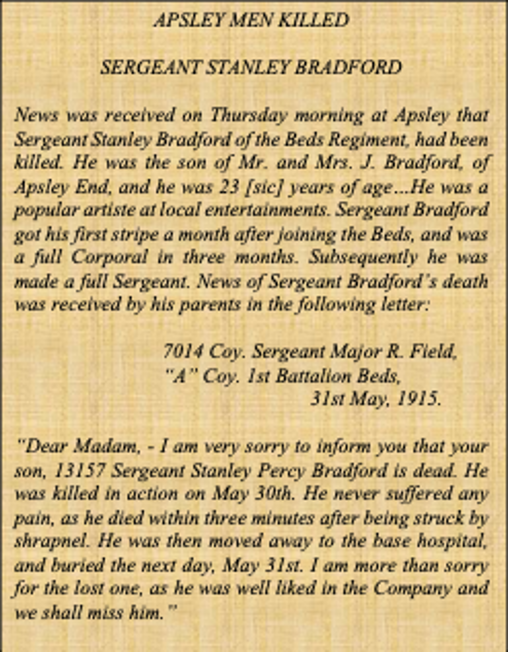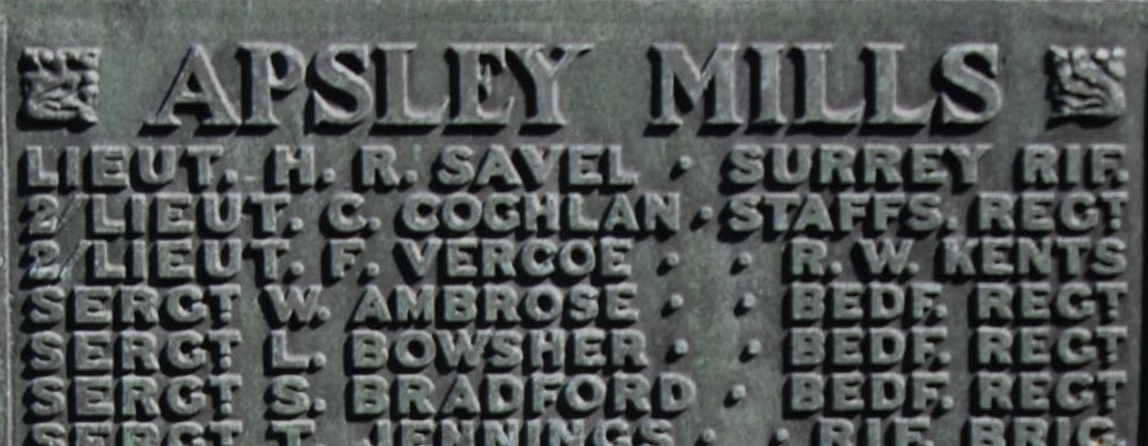Fallen in May 1915:
Frank Fowler
Harry Holden
William Somerville
Paul Frederick Hebert
Arthur Mitchell
Gilbert Robert Mitchell-Innes
Edwin Walter Cox
Leonard Ellison
Edward James Bladon
Alfred Herring
Nimrod Oakins
William John Parish
Stanley Percival Bradford
FRANK FOWLER
13305 Private
1st Bn., Bedfordshire Regiment
Killed in Action Wednesday, 5th May 1915
Remembered with Honour, Bedford House Cemetery, West-Vlaanderen, Belgium, Enclosure No.4 XI.D.9.
Francis Fowler, known as Frank, was born in 1887 in Great Gaddesden the third son of Henry and Adelaide Chappel. He was christened on the 31st July 1887 in the church of St. John the Baptist, Great Gaddesden when his parents were living in ‘Bird’s Cottages’, Potten End.
Frank was one of five brothers; Albert (Bert) and William (Will) who were older, then Arthur and Sidney, both younger. All five sons of Henry and Adelaide served in the Great War, four of whom survived the conflict.
Henry Fowler was working as a Bricklayers Labourer when Frank was born, but by 1901 he was recorded as a Gardener on the census return and the family had moved to 17 Chapel Street in Hemel Hempstead. Frank was an Errand Boy at fourteen years of age.
By 1911 Frank was working as a Book
Binder and living with his family at 36 Alma Road, one of the lost streets of
Hemel Hempstead. Alma Road, previously Gade Street, had been so named to
commemorate the Battle of Alma in the Crimean War. It ran from Bury Road to
join with Marlowes, but it was demolished in the 1960’s to make way for West
Herts College.
Frank attested between 28th August and 3rd September at Hemel Hempstead. After completing his basic training, he left for France and disembarked there on 27th April 1915. He joined his Battalion three days later on 30th April at Ouderdom about five miles west of Ypres. It appears he was one of 100 men sent straight to the trenches the same night. The Battalion war diaries record events:
"30 Apr 1915 Do. Draft of three officers & 300 other ranks arrived at
OUDERDOM. One officer & 100 men sent on same night to trenches. Some
difficulty in getting stores & supplies to trenches recently owing to
constant & persistent shelling of all roads & approaches by enemy.
Casualties - 1 killed, 1 wounded"
Only five days later Frank was killed
in the trenches during ferocious fighting as the Germans attempted to recapture
Hill 60:
"5 May 1915 At a little after 8 a.m. enemy attacked with asphyxiating gas laid on from two points opposite our trenches. Battn stuck to its trenches, though a few men killed by gas, & all were badly affected. Troops on right, however, were driven out of trenches & enemy captured Hill 60 & trenches on our immediate right. Our left trenches were then attacked but drove back enemy: our right trenches were attacked all day with bombs, rifles & machine guns. Desperate fight all day enemy & selves in same trench, both sides using hand grenades fiercely. Enemy eventually worked round our right flank & enfiladed our right, but men gallantly maintained their position. A Battery of our own artillery spent the whole day firing into our own right trenches, causing many casualties but in spite of everything right trenches held out."
Frank almost certainly experienced the
gas attack, although he was Killed in Action on Wednesday, 5th May. Shortly
afterwards the Battalion War Diaries recorded the high number of casualties:
Alma Road, Hemel Hempstead 1897 (Courtesy: Old OS Maps)
Extract from the Hemel Hempstead Gazette and West Herts Advertiser 2nd Oct. 1915
Bedford House Cemetery, West-Vlaanderen, Belgium (Courtesy: CWGC)
"7 May 1915 - hutments near Ouderdom Battn relieved by R.I.Rifles about 2 a.m. & marched back to hutments in reserve. Casualties during two previous days about 3 officers & 290 men."
Frank was one of six Hemel men who were killed at Hill 60. His death was reported in the Hemel Gazette in October 1915 and information about his four brothers was also detailed. (see extract)
Frank appears on the Hemel Hempstead War Memorial twice, once as Francis and once as Frank.
He is Remembered with Honour at Bedford House Cemetery, West-Vlaanderen, Belgium where he is interred in Enclosure No.4 XI. D. 9.
Frank was 27 years old when he was killed.
He was eligible for the 1914-15 Star, the British War Medal and the Allied Victory Medal.
HARRY HOLDEN
63890 Gunner
123rd Battery, Royal Field Artillery
Killed in Action Wednesday, 5th May 1915
Remembered with Honour, Hooge Crater Cemetery, West-Vlaanderen, Belgium, Grave: XVII. A. 12.
Henry Holden, known as Harry, was born on the 4th September 1895 to John and Elizabeth, their third child and first son. The location of his birth is a little confused with the 1901 Census recording Boxmoor as his birthplace, whilst on enlistment in the Army, Harry gives his place of birth as Kings Langley. Harry had two older sisters, Dora and Jenny and a younger brother Charles.
All four children were born in or near Hemel Hempstead, but the family had moved to South Norwood near Croydon by 1901. Harry joined his sister Jenny at Whitehorse Road Infants School in Croydon on the 24th April 1899, at the age of three years and seven months, shortly after his family had moved to the area. Ten years later on the 14th March 1909, he completed his education and left Whitehorse Road to start work as a Butcher’s Errand Boy at the age of fourteen.
Harry enlisted as a regular soldier
with the Royal Field Artillery (RFA) sometime before the outbreak of the Great
War. Records show that he attested in London and joined the 123rd Battery RFA. This was a unit of Britain’s pre-war regular army and was part of
the 28th Brigade RFA. It Comprised 122nd, 123rd and 124th Batteries, under command of the 5th Infantry
Division. In August 1914 it mobilised and was sent to the Continent with the
British Expeditionary Force, where it saw service throughout the war.
The 28th Brigade was at Dundalk in Ireland at the outbreak of war and mobilised on 17th August 1914, embarking from Belfast on the SS Mesaba and sailing "in perfect weather". Disembarkation at Havre in France took place two days later on the 19th August. As part of the BEF Harry saw action in most of the major engagements during 1914 beginning at Le Cateau, where the Brigade suffered it’s first casualties due to heavy shelling by the enemy.
He survived the Battles of the Marne
and Aisne, La Bassee and Messines and the First Battle of Ypres. Following a
winter spent mainly in reserve, he then saw action in The Second Battle of
Ypres before he fell on 5th May 1915 at Hill 60, the fourth Hemel
Hempstead man to die there.
The War Diaries did not record Harry’s death, so it is not clear how he was killed. The Diaries do however, offer a graphic description of the German gas attacks and the almost non-stop bombardment by both sides from 9am to 11pm, and the failed efforts to retake Hill 60 by the British:
"Wednesday May 5th……At 8.40am all batteries opened rapid fire around the front at Hill 60, as Germans have attacked and are using “gas”. 9am Learn that Germans have captured “60”. Turn guns on to the crest of the hill..."
During that day there was continued firing of varying intensity and some of the trenches were recaptured from the Germans. However, by late evening news that Hill 60 had not been retaken by the British filtered through:
"May 5th 11pm Hear attack has failed owing to concentrated
German fire from all directions"
Harry is Remembered with Honour at Hooge Crater Cemetery, West-Vlaanderen, Belgium where he is interred in Grave: XVII. A. 12.
Harry was only 20 years old when he was killed. He was eligible for the 1914-15 Star, the British War Medal and the Allied Victory Medal.
Royal Field Artillery Cap Badge, World War 1
RFA Gun Crew in Belgium (Courtesy: IWM)
Area around Hill 60 at the end of the War (Courtesy: The Long, Long Trail)
Hooge Crater Cemetery, West-Vlaanderen, Belgium (Courtesy: CWGC)
WILLIAM SOMMERVILLE
13786 Lance Corporal
1st Bn., Bedfordshire Regiment
Killed in Action Wednesday, 5th May 1915
Remembered with Honour, Ypres (Menin Gate) Memorial, West Vlaanderen, Belgium, Panels 31 and 33
William Sommerville was born Robert William Collings in St Pancras, London on the 15th June 1879. He was the youngest child and only son of Robert Collings and Harriet Anne Frost and he had four older sisters. His siblings were: Elizabeth Charlotte Florence, Lilian Gertrude, Esther Agnes and Maude Maria.
Robert
Collings died in 1880 and his wife Harriet Anne remarried a year later.
William’s step father was Charles John Sommerville and by 1891, William was
living with Charles and Harriet in Wood Green, North London and had adopted his
step father’s surname Sommerville.
Following the outbreak of the Second Boer War in October 1899, William enlisted in the City of London Imperial Volunteers. This was one of the many volunteer corps established to provide officers and men for service in South Africa. All the officers and men received the Freedom of the City of London before their departure.
The corps was part of the huge force assembled to relieve Kimberley on the 15th February 1900, and came under fire for the first time during actions at Jacobsdal the following day. William served from January to October 1900 and returned to England just before the corps was disbanded on the 1st December of the same year.
Following service in the Second Boer War, William was again living with his step father in Wood Green in 1901. At this time his mother was an inmate in Edmonton workhouse nearby and research suggests she was suffering from illness and could not be cared for at home. Coincidentally, William’s sister Maude Maria was working as an Officer in another Union Workhouse in 1901 and she would go on to qualify as a midwife in 1903. William was working as a Machinist in a Shirt Factory.
Two years later on the Saturday, 25th April 1903, he married Alice Swallow at St Anne’s Parish Church in Islington. William and Alice had three daughters together, Alice Louise Collings, Maud Collings and Doris Collings. Shortly after Doris’ birth the family moved to Apsley End and William started work as a Wood Sawyer at John Dickinson and Co. Ltd. The family lived at 21 Weymouth Street in Apsley End.
William was amongst the first great surge of volunteers after the defeat at Mons and he enlisted in late August in the 1st Battalion Bedfordshire Regiment. Following his basic training he left for France, disembarking on the 2nd February 1915 before joining his battalion in billets at Bailleul on the 8th February. He saw action in the trenches in France before moving with the Battalion to the Ypres salient early in March 1915.
Here he was
engaged with his comrades at the Second Battle of Ypres, defending Hill 60
where two days before the end of this engagement, William was killed on the 5th May 1915. He was one of 290 men from the
1st Battalion killed or injured on the 5th and 6th of May.
William Sommerville c.1914 (Courtesy: Hertfordshire, Hemel Hemstead Gazette and West Herts Advertiser 13th May 1916)
John Dickinson & Co. Limited, War Memorial
Apsley-End (Photo: Traquair Photography 30th Aug. 2016)
Ypres (Menin Gate) Memorial, West Vlaanderen, Belgium (Courtesy: CWGC)
William’s name is engraved as Somerville on the Hemel Hempstead War Memorial and this appears to be incorrect. All other records researched record his name as Sommerville including the John Dickinson War Memorial in Apsley where he is also commemorated.
He is Remembered with Honour at Ypres, Belgium on the Menin Gate Memorial, Panels 31 and 33.
William was 35 years old when he was killed.
He was eligible for the 1914-15 Star, the British War Medal and the Allied Victory Medal.
Pablo Frederick Hebert, known as Paul, was born in Bueno Aires, Argentina on the 12th January 1893 the oldest son of Henry Frederick and Charlotte Emma. Paul had six younger siblings, four sisters; Dorothy Elisa Emma, Mary Ricardo, Edith and Winifred Emma; and two brothers, Hugh Ricardo Melbourne and Alexander. His younger brother Hugh also fought in the Great War with the 1st Hertfordshire Battalion and survived the conflict.
The rather exotic children’s names are reference to their father’s origins and their parents travels across the world. Henry Hebert was born in Geelong, Victoria, Australia in 1857 and met Charlotte in Camden Town when his parents came back to England in the 1880’s. Henry was a Company Secretary for a cattle concern and after marrying Charlotte in 1892, his work took them to Argentina where Paul and Dorothy were born. The family had returned to England and Hemel Hempstead by 1896 and their other five children were all born there.
The Hebert family were living in Park Lane in Hemel in 1901 and Paul along with his brother Hugh, were enrolled at Boxmoor JMI school in December of the same year by which time the Hebert’s had moved to Green End Road. He stayed there for two years before leaving for Margate College. Two years later in 1905 he is back at school in Hemel Hempstead, this time at the Two Waters British School. Confusingly the admission records record his previous school as ‘Berkhampsted Sch.’ not Margate College however, Paul completed his education in April 1908 when he left to start work as a Clerk in a mill.
In 1908 Paul volunteered for the Royal Navy and signed up for future service to begin in 1910 for twelve years. He was sent initially to the RN training establishment HMS Ganges at Shotley in Essex for induction into Navy life, but this proved to be short lived. His Naval service records states that whilst of very good character he was "discharged to shore for being unsuitable R.N. Lacking in Spirit".
It is clear that Paul was determined to have a career at sea and after what must have been a disappointing set back with the Royal Navy, he instead turned to the Merchant Navy. In London on the 14th February 1910 aged seventeen, he was successfully indentured as an apprentice to the Tyzack and Branfoot Steam Shipping Co. Ltd (Sunderland) for a period of four years. He served on the SS Shadwell and successfully completed his Engineers exam in 1911. The SS Shadwell was torpedoed in the Mediterranean on 23rd March 1918 and thirteen men were killed.
Following
completion of his apprenticeship it appears that Paul did not continue with
service in the Merchant Navy and on the outbreak of war he instead enlisted in
the Army. He attested on the 3rd September 1914 at Caxton Hall,
Westminster in London and joined the 2nd Battalion Rifle Brigade.
On enlistment, Paul stood 5 feet 7¼ inches tall and weighed 10 stones, with a fresh complexion, brown eyes and brown hair. His time as a sailor resulted in some traditional naval tattoos and he was considered fit and healthy for military service.
He started basic training at Winchester in September 1914 before leaving for France four months later. The 2nd Battalion had landed at Le Havre as part of the 25th Brigade in the 8th Division in November 1914 and Paul followed, disembarking at Le Havre on the 19th January 1915. By 2nd February he had joined his comrades at Estaires and soon saw action in the trenches and was amongst the first troops to enter Neuve Chapelle following the battle there between the 10th and 13th March 1915.
By early May the Battalion had moved to a position south of the village of Laventie in preparation for the assault on Aubers Ridge. The Battle of Aubers Ridge took place on the 9th May 1915 and it was during this engagement that Paul was mortally wounded.
The 2nd Battalion Rifle Brigade initially succeeded in capturing the German trench in front of them and continued to advance despite severe casualties. However, throughout the day the Battalion came under heavy German shelling, machine gun fire and counter attacks and despite a gallant defence, it was eventually driven back from the enemy trenches. The War Diary lists the casualties:
"May 12th Rested in billets. Casualties during recent engagement:- 77 Killed - 340 Wounded – 194 Missing – 18 Wounded & Missing. Officers 9 Killed – 8 Wounded – 4 Missing."
It is not
clear when Paul actually died but his Service Record states "Regarded for official purposes to have died
on or since 9-5-15"
Rifle Brigade Cap Badge, World War 1
Extract from the Hertfordshire, Hemel Hempstead Gazette and West Herts Advertiser 5th Jun. 1915
Extract from the Hertfordshire, Hemel Hempstead Gazette and West Herts Advertiser 13th May 1916
Ploegsteert Memorial, Hainaut, Belgium (Courtesy: CWGC)
Paul was initially listed as wounded and a report appeared in the Hemel Gazette in June 1915. (see extract)
It was to be another year before his father Henry received official confirmation of Paul’s death. Henry served as an Alderman on the town Council and in May 1916 it formally recorded its sympathy for the death of his son.(see extract)
Paul is Remembered with Honour on Ploegsteert Memorial, Hainaut, Belgium, Panel 10.
He was 22 years old when he died.
Paul was eligible for the 1914-15 Star, the British War Medal and the Allied Victory Medal.
Arthur Mitchell was born in 1888 at Gaddesden Row and baptised in the same year on the 25th November in the church of St John the Baptist, Great Gaddesden. His father was Joseph Mitchell, an Agricultural Labourer and his mother was Sarah Gregory. Arthur had twelve siblings of whom eleven are known. There were six girls; Annie, Alice ‘Jane’, Lillie, Elizabeth, Emma and Louisa. His five brothers were; Henry ‘Harry’, Frederick, George, James and Edward. Three of the children had died by 1911, James in 1898, Lillie in 1908 and one other child whose name, and gender are unknown.
Arthur was the sixth child and when he was born the family lived at Wood Farm which still stands today between Piccott’s End and Gaddesden Row. Indeed, in later census returns Joseph had moved his family to other farms and by 1911, when Arthur was twenty-one he had joined his father on the land and was working as a Horseman.
At the time of Arthur’s death, Joseph and Sarah were living at ‘1, Adey Fields, Hemel Hempstead,’ which was in all likelihood Adeyfield Farm which eventually disappeared with the coming of the New Town after the Second World War.
On the outbreak of war, Arthur enlisted with the Bedfordshire Regiment at Hemel Hempstead, between the 31st August and the 3rd September 1914. He then joined the 3rd Battalion Bedfordshires a ‘Reserve’ battalion whose function at the time was twofold; first it provided part of the East Coast Defence Force posted to Landguard Fort in Felixstowe; and second it trained the drafts of volunteers before they were sent to join the two Regular battalions engaged on the Western Front during 1914 and 1915.
On completion of his training Arthur went to France and disembarked on the 1st April 1915 at Le Havre. By 22nd April he was with the Battalion near Zilibeke in Belgium and he saw his first action in the trenches around Hill 60.
Arthur was possibly the first soldier from Hemel Hempstead to die chiefly as a result of German gas attacks. On the morning of the 5th May the battalion War Diary records an attack:
"5 May 1915 At a little after 8 a.m. enemy attacked with asphyxiating gas laid on from two points opposite our trenches. Battn stuck to its trenches, though a few men killed by gas, & all were badly affected."
Arthur was
one of the soldiers ‘badly affected’ and he was evacuated to No. 13 General
Hospital in Boulogne. It was here that, despite making some progress towards a
recovery, that he died on 11th May 1915.
The General (Base) Hospital was part of the casualty evacuation chain, further back from the front line than the Casualty Clearing Stations. They were manned by troops of the Royal Army Medical Corps, with attached Royal Engineers and men of the Army Service Corps. In the theatre of war in France and Flanders, the British hospitals were generally located near the coast. They needed to be close to a railway line, in order for casualties to arrive (although some also came by canal barge); they also needed to be near a port where men could be evacuated for longer-term treatment in Britain.
The "asphyxiating gas" was probably chlorine as a symptom of poisoning by chlorine gas is bronchitis and this was the cause of Arthur’s death.
His father
received a letter from a Sister Holmes which described his passing. (see extract)
A touching piece,
published on the same day, reported his death and described the efforts of his
fiancée to see him in hospital. (see extract)
Great Gaddesden War Memorial, St John the Baptist Church, Great Gaddesden (Photo: Traquair Photography 26th Oct. 2020)
Ward 3, No.13 General Hospital, Boulogne-sur-Mer, France (Courtesy: IWM Q29162)
Extract from the Hertfordshire, Hemel Hempstead Gazette and West Herts Advertiser 29th May 1915
Extract from the Hertfordshire, Hemel Hempstead Gazette and West Herts Advertiser 29th May 1915
Boulogne Eastern Cemetery, Pas de Calais, France (Courtesy: CWGC)
Arthur is Remembered with Honour at the Boulogne Eastern Cemetery, Pas de Calais, France where he is interred in Plot: VIII. C. 20. The inscription on his headstone, requested by his mother Sarah, reads: “OUR LOVED ONE GONE BUT NOT FORGOTTEN”
He is also commemorated on the Great Gaddesden War Memorial.
Arthur was 27 years old when he died.
He was eligible for the 1914-15 Star, the British War Medal and the Allied Victory Medal.
GILBERT ROBERT MITCHELL-INNES
Lieutenant
"A" Sqdn., 19th
(Queen Alexandra's Own Royal) Hussars
Died of Wounds Saturday, 15th May 1915
Remembered with Honour, Vlamertinghe Military Cemetery, West-Vlaanderen, Belgium, Plot: I. E. 9
Gilbert
Robert Mitchell-Innes was born on the 27th February 1895 in
Bournemouth, Hampshire. He was the only son of Edward Alfred Mitchell-Innes,
K.C., and Annie Barbara Laycock, of ‘Churchill’, Hemel Hempstead. He had one
older sister, Josephine and three younger sisters, Norma Margaret, Rhoda
Frederic and the youngest, Elizabeth.
Gilbert
came from a wealthy family which was prominent in the social and political life
of Hemel Hempstead. His father Edward was a Barrister and King’s Counsel and a
member of both the Borough and County Councils. He sat on the Joint Hospital
Board and was Mayor and Bailiff of the town between 1911 and 1913.
The family
lived at ‘Churchill’, formerly known as ‘The Heath’, leaving it in 1932 after
Edward’s death. It is remembered by older Hemel Hempsteadians as the site of
the Churchill swimming baths, opened in 1939. The house was demolished in 1960
and the location where it stood is now the site of a sports centre.
Gilbert was educated at Eton College which he left in 1912 when he entered the Royal Military College at Sandhurst. He left Sandhurst on the outbreak of war in August 1914 and received his first appointment as a 2nd Lieutenant in the 19th (Queen Alexandra’s Own Royal) Hussars.
At the start of the War the regiment had been split into three squadrons, A, B and C. These were attached to the 5th, 4th and 6th Infantry Divisions respectively, as divisional cavalry squadrons. All three divisions moved to France with the British Expeditionary Force in August and September 1914, and saw action in the Battle of Le Cateau, the Retreat from Mons, the Battles of the Marne and the Aisne and the Battle of Armentières. In April 1915 the three Squadrons returned, and the regiment was reformed and placed under the command of 9th Cavalry Brigade in 1st Cavalry Division.
From August to December 1914 Gilbert was at Hounslow and in November of that year he was promoted temporarily Lieutenant with ‘A’ Squadron. He went to join his regiment in France and disembarked there on the 5th February 1915. He soon saw action at the Second Battle of Ypres in spring 1915, fighting in the Battle of St Julien in April and the Battle of Frezenberg in May.
It was on the final day of the Battle of Frezenberg that Gilbert was mortally wounded. The 19th Hussars had been called up to support a centre attack and had to dig themselves into a wet ditch exposed to galling fire. During this operation Gilbert was hit, while superintending the work. It was reported that he behaved with "conspicuous courage setting a fine example of pluck and endurance to his men"
Gilbert died of the effects of his injuries two days later on 15th May 1915
His death
was reported in the Hemel Gazette shortly afterwards. (see extract)
Two years
after his death his parents presented a lectern in his memory to St John the
Evangelist Church in Boxmoor where he is also commemorated on a memorial plaque. (see extract)
Gilbert is Remembered
with Honour at Vlamertinghe Military Cemetery, West-Vlaanderen, Belgium: Plot:
I. E. 9. The inscription on his headstone, requested by his father Edward,
reads: “FROM GLORY TO GLORY”
He was 20 years old when he died.
Gilbert was eligible for the 1914-15 Star, the British War Medal and the Allied Victory Medal.
Grave of Gilbert Robert Mitchell-Innes (photo: Traquair Photography)
Gilbert Robert Mitchell-Innes c.1912 (Courtesy: IWM, Bond of Sacrifice - First World War Portraits Collection)
Extract from the Hertfordshire, Hemel Hempstead Gazette and West Herts Advertiser 22nd May 1915
Extract from the Hertfordshire, Hemel Hempstead Gazette and West Herts Advertiser 26th May 1917
‘Churchill’, Park Road, Boxmoor
EDWIN WALTER COX
12992 Private
2nd Bn., Bedfordshire Regiment
Died of Wounds Sunday, 16th May 1915
Remembered with Honour, Chocques Military Cemetery, Pas de Calais, France, Plot I. C. 5.
Edwin Walter Cox was born in Bethnal Green, London in 1894 and baptised at St Simon Zelotes church on the 12th September in the same year. He was the second and youngest son of Albert Henry Cox and Emma Larbey. Edwin, known as Ted, had two older siblings, Albert Henry and Emma.
When Ted
was born the family were living at 186 Devonshire Street in Bethnal Green and
his father was employed as a Vellum Binder. Albert may already have been
working for John Dickinsons Ltd., but this was certainly the case by 1901 when
the family had relocated to 10 Featherbed Lane, Two Waters, Apsley. His older
brother Albert was also working as a Vellum Binder with John Dickinsons.
When Ted left school in 1907 he started work with Pemsel and Wilson Ltd. Arthur F Pemsel had established this business as the first motor bus company to serve Hemel Hempstead. The bus took passengers from the Posting House at the junction of Bury Road and Marlowes to Boxmoor station. By 1911 however, Ted had joined his father, brother and sister Emma at John Dickinsons, where he was employed as a General Porter. The family had also moved by this time and was living at ‘Apsley View’ on Ebberns Road, Boxmoor.
Ted attested at Hemel Hempstead in late August 1914 and enlisted with the 2nd Battalion Bedfordshire Regiment. The 2nd Battalion was in South Africa at the outbreak of war and was immediately recalled to England, landing at Southampton on 19 September 1914 and forming part of the 'Immortal' 7th Division in the 21st Brigade. The division left Southampton on the 5th October 1914, and disembarked in Zeebrugge two days later.
In the meantime, Ted was undergoing his basic training at Harwich and it was not until March of the following year that he was sent to France. He disembarked on 17th March 1915 and by the 22nd March he had joined with the 2nd Bn. near Laventie and was assigned to ‘C’ Company, 9th platoon.
He soon saw
his first action in the trenches late in March and shortly afterwards he wrote
to his brother Albert giving a quite detailed description of the dangers
apparent from German snipers ‘The German
snipers are crack shots’ and some near misses which he experienced.
Extracts from the letter were published in the Gazette in April 1915. (see extract)
By the 11th May the 2nd Battalion had moved to Festubert and for the next four days was engaged in trench improvement works and night patrols. All this in preparation for the planned assault on the 16th May. It was during this activity that Ted was mortally wounded.
One
Corporal Arthur Wesley Joyce wrote a touching letter to Ted’s parents
describing the circumstances of his death and offering solace for the loss of
their “bright happy lad”. The
contents of the letter were published in the Gazette shortly after Ted had
died. It states that he had been wounded in the head on 13th May at
about seven o’clock in the evening and that “no
hopes were entertained of his recovery from the first”. Ted was moved to a
clearing station but sadly died of his wounds a few days later on Sunday, 16th May 1915. (see extract)
Ted is Remembered with Honour at Chocques
Military Cemetery, Pas de Calais, France where he is interred in Plot I C 5.
The inscription on his headstone, requested by his father Albert, reads: “I’M
BUT A STRANGER HERE HEAVEN IS MY HOME”
He is also commemorated on the John Dickinson memorial in Apsley.
Ted was only 20 years old when he died.
He was eligible for the 1914-15 Star, the British War Medal and the Allied Victory Medal.
Chocques Military Cemetery, Pas de Calais, France (Courtesy: CWGC)
Private Edwin (Ted) Walter Cox c 1914 (Courtesy: Hertfordshire, Hemel Hempstead Gazette and West Herts Advertiser)
Extract from the Hertfordshire, Hemel Hempstead Gazette and West Herts Advertiser 17th Apr. 1915
Extract from the Hertfordshire, Hemel Hempstead Gazette and West Herts Advertiser 22nd May 1915
LEONARD ELLISON
14632 Private
2nd Bn., Bedfordshire Regiment
Killed in Action Sunday, 16th May 1915
Remembered with Honour, Le Touret Memorial, Pas de Calais, France, Panel 10 & 11
Albert Leonard
Ellison was born in July 1890 in Hampstead, Middlesex, the fourth son of Henry
Ellison and Emily Berry and known as Len to his family. William, Joseph and
Herbert were Len’s older brothers and he had six younger sisters and brothers;
Eva, Bertie, Beatrice, Edith, Alexander and the youngest child Leslie.
When Len was born the family lived in Hampstead where his father worked as a Gardener and by 1901 they were living in the Lodge at Roundwood House in Willesden where Henry was Head Gardener. His employer was the renowned Victorian construction engineer and benefactor George Furness and it may have been due to his death in 1900, followed soon after in 1902 by the tragic drowning of Sarah Rebecca Furness his wife, that led to Henry Ellison seeking employment elsewhere.
By 1911 the family had moved to Hemel Hempstead and Henry was working as a Gardener at ‘Orchard House’ on Bury Hill. Twenty-year-old Len was employed as a Groom and worked for Mr Gregory Hast owner of Adeyfield Farm.
In common with many men working in occupations such as farming and agricultural labouring, Len enlisted on the 19th December 1908 in the newly formed Territorial Force (TF), as a way of supplementing his wage. The Territorial Force (TF) was the volunteer reserve component of the British Army and came into existence in 1908 following government legislation specifically, the Territorial and Reserve Forces Act 1907. This act combined and re-organised the old Volunteer Army with the Yeomanry. The initial impetus for the creation of the TF came from Joseph Lyons, who also co-founded the eponymous chain of cafes known as the Lyons Corner Houses.
The TF was formed on 1 April 1908 and as part of the same process, remaining units of militia were renamed Special Reserve. It was envisaged as a home defence force for service during wartime and units were liable to serve anywhere within the United Kingdom when the force was embodied, but could not be compelled to serve outside the country.
Len enlisted with 2 Battery Hertfordshire Royal Field Artillery attached to the 4th East Anglian Brigade. 2 Battery formed at Clarendon Hall, Watford, from elements of the 2nd Hertfordshire Volunteer Bn. of the Bedfordshire Regiment.
Aged eighteen and a half, Len was 5ft 2½in tall and his physical condition was ‘Fair’, good enough to pass him ‘Fit’ for military service and his appointment was duly approved. He became 229 Driver Ellison and over the next four years attended annual training camps with the TF at Lydd in Kent, Thetford in Norfolk and finally at Salisbury Plain in Wiltshire in 1912. His service with the TF terminated on the 18th December 1912 the end of his four-year term.
On the outbreak of war, Len re-enlisted in the last week of August 1914 at Hemel Hempstead with the 2nd Battalion Bedfordshire Regiment. He trained at Harwich before being sent to France in 1915 where he disembarked on the 17th March as part of the 21st Brigade in the 7th Division. He joined the regiment on the 20th March along with the Commanding Officer of the 2nd Beds, Major John Mackenzie VC DCM who was killed one day after Len at the Battle of Festubert.
On the 12th April, Len was present when Sir John French, Commander in Chief of the British Expeditionary Force inspected and addressed each of the Battalions at Estaires. He began by acknowledging the gallantry of the Bedfordshires at the Battle of Neuve Chappelle: “Men of Bedfordshire - I have come here today to tell you how much indebted I am to you for your recent work. I know what you have done. I know the losses you have suffered. I need not go into the detail of the part you played in the three days battle at NEUVE CHAPELLE. But I know no Battalion pushed forward with more gallantry than you did.” He concluded by saying: “I want every officer, Non-commissioned officer and man of this Regiment to feel that I give them my personal thanks for the splendid work that they have done.” The Battalion war diaries record that there were twenty-four officers and 779 other ranks present when Sir John spoke.
Just over one month later, Len took part in the Battle of Festubert which was the first British army night attack of the war. The war diaries record that: "16 May 1915 7th Division attack at 3 a.m. 21st Inf.Bde. in reserve. After successful assault of enemy trenches by 20th & 22nd Bdes. 'D' & 'A' Coys. after supporting assault with covering fires, with machine Guns under 2nd Lt.W.H.George [Walter Hope GEORGE] on right flank, occupied old German trench consolidating it & turning it into fire trench, for our use…" It was after this assault, whilst holding the captured German trenches, that Len was killed.
It appears he died instantly having been shot in the back of the neck as witnessed by his friend and Corporal D. Lyall. Lyall subsequently wrote to Len’s family and details of his letter were published in the Gazette a fortnight later.
Corporal
Lyall explained how Len died and that his comrades were unable to bury him due
to orders for the Battalion to move. This must have been distressing news for Len’s family but it was not uncommon for
fallen soldiers to be left where they lay in the heat of battle and often other
units following behind had the task of burying the dead after actions had
ceased. (see extract)
Albert Leonard Ellison c1914 (Courtesy: The Hertfordshire, Hemel Hempstead Gazette and West Herts Advertiser
Extract from the Hertfordshire, Hemel Hempstead Gazette and West Herts Advertiser 10th Jul. 1915
Le Touret Memorial, Pas de Calais, France (Courtesy: CWGC)
A further letter was received by his parents from Private Alfred Hoe who was wounded shortly before Len was killed. Private Hoe wrote from his hospital bed to offer sympathy and said that: ‘It was planned between him and Leonard that if one of them was unlucky they would write to the parents.’ This was done while they were under terrific shell fire.
It appears that both of Len’s comrades who had written to his family survived the conflict.
Len was killed on Sunday, 16th May 1915.
He is Remembered with Honour at Le Touret Memorial, Pas de Calais, France on Panel 10 & 11.
Len was only 20 years old when he died.
He was eligible for the 1914-15 Star, the British War Medal and the Allied Victory Medal.
Edward
James Bladon was born at Potten End, Hertfordshire in early 1889. He was the
youngest son of Joseph Bladon and Rebecca Nash Pearce who had a large family of
twelve children. Edward’s siblings were: Anne Louise, Emily, Rebecca, Annie,
Clara Elizabeth, Rose, Frederic Rosea, Hezekiah John, Mary, Joseph Micaiah and
Mercy. The first and last-born children died in infancy and Edward’s brother
Joseph died in 1901 aged sixteen.
His father Joseph was a Watercress Grower, initially working in Rickmansworth before setting up in business on his own account. He moved with his family to Water End near Hemel Hempstead in 1890 where they lived in ‘Spring Cottage’. Joseph regularly advertised his business in local newspapers and appears to have had a successful enterprise until 1894 when it failed.
Because of
this commercial catastrophe, Rebecca and four of the youngest children,
including Edward aged twelve, moved to Boxmoor, Hertfordshire to live with an
older married daughter Annie. The 1901 Census records that they lived with
Annie and her husband William Fossey in Hammerfield, Boxmoor and that Rebecca
and her daughter Rose had found employment as Envelope Makers with John
Dickinsons. Edward’s father Joseph is not present on the Census return.
Edward followed his older brother Hezekiah into the regular army and enlisted with the 2nd Battalion Bedfordshire Regiment sometime before 1909. ‘Bandsman’ Bladon was a drummer in ‘C’ Company and he was at St George’s in Bermuda with the Battalion in 1911 before moving with it to Robert’s Heights, Praetoria in South Africa a year later.
At the outbreak of war, the 2nd Beds immediately returned to England, landing at Southampton on the 19th September 1914 and forming part of the 'Immortal' 7th Division. Having refitted for European warfare, the division left Southampton at 8 a.m. on the 5th October, on board the S.S. Winifredian and after a brief stop at Dover for supplies, landed in Zeebrugge at 6.30 a.m. on the 7th October 1914.
Eleven days later on the 18th October, Edward saw action with the unit on the Menin Road near Gheluvelt and the Battalion suffered it’s first casualties "1 sergeant & 1 man killed 21 other ranks wounded 2 other ranks missing." This engagement took place on the eve of the First Battle of Ypres which continued until 22nd November 1914 and the Battalion suffered very significant casualties during the fighting.
On
Christmas day 1914, Edward wrote to his family from the trenches describing his
‘lucky escape’ and how he rescued a wounded colleague under dangerous
circumstances. The details of his story were reported in the Gazette in January
1915 and give some hint of the appalling risks and the fear that the soldiers
faced in the conflict. (see extract)
By the time he wrote home in December 1915, Edward had moved with the Regiment to France and he saw significant action again in March of the same year at the Battle of Neuve Chapelle where once again casualties were heavy. Edward survived the battle, but his luck was to run out a little over two months later at the Battle of Festubert.
Edward was wounded at some point on the 16th or 17th May during the British attacks on the German trenches and died of his wounds on Monday, 17th May 1915.
His death was one of 4,123 casualties suffered by the 7th Division and of the 16,648 British casualties between the 15th and 25th May, before Festubert was finally captured for a gain of some 1.9 miles. (The approximate distance from the War Memorial in Hemel Hempstead to Leverstock Green)
Edward is Remembered
with Honour at Le Touret Memorial, Pas de Calais, France: Panel 10 and 11.
He was 26 years old when he died. Edward was eligible for the 1914-15 Star, the British War Medal and the Allied Victory Medal.
Le Touret Memorial, Pas de Calais, France (Courtesy: CWGC)
Private Edward James Bladon (Courtesy: The Hertfordshire, Hemel Hempstead Gazette and West Herts Advertiser)
Courtesy: Herts Advertiser 25th June 1892
Extract from the Hertfordshire, Hemel Hempstead Gazette and West Herts Advertiser 16th Jan. 1915
Alfred Herring
was born on Friday, 14th November 1884 in Watford, Hertfordshire, and
was baptised on Wednesday, 8th April in the following year at St Mary’s Church
on Watford High Street. He was the first child and oldest son of William Robert
Herring and Elizabeth Owen. Alfred had six younger sisters: Lily, Helen
(Nellie), Dorothy, Margaret (Maggie), Alice, and Maud. His only brother was
William Harry who also fought with the Bedfordshire Regiment and survived the
war.
The Herring family lived at 28 Estcourt Road when Alfred was born a few doors away for the town’s first purpose-built police station at the junction of Beechen Grove. Alfred’s education began on 12th January 1891 at Beechen Grove Board School and he completed his schooling on the 5th July 1897.
By 1891 the family had moved to Shafford’s Bottom, in Apsley End and sixteen-year-old Alfred was working at John Dickinson as a Paper Maker’s Assistant. He then met Mary Element from Chipperfield and they married in 1909 in Hemel Hempstead and set up home on Durrant’s Hill Road in Apsley. They moved just over a year later to 11 Two Waters Road, Boxmoor where their only child Margaret Elizabeth was born in late 1910.
Alfred worked as a Vermin Killer. Killing vermin and rat catching particularly, was a busy occupation at this time due to insanitary conditions and the storage of grain and other foodstuffs in close to dwellings and water courses. Typically, the work was done with Terriers and Ferrets and whilst not the happiest of occupations it would have kept Alfred busy.
Alfred enlisted with the 2nd Bedfordshire Regiment in September 1914 and completed his basic training in Harwich. He was sent to France in 1915 and disembarked on the 21st April and was one of a draft of seventy-seven men which joined with the 2nd Battalion at Estaires on the 27th April 1915.
His first action was at the Battle of Festubert on 16th May 1915 as part of the British attack. His involvement was short-lived however, and he died on the Monday, 17th May 1915.
His death was the result of drowning in one of the water filled ditches which traversed the battlefield. The Battalion War Diaries for that day records the following: “…information was received by the C.O. that Lt.Col.Thorpe had called a halt, as he was unable to collect a party sufficiently strong to assault the German position, owing to the darkness, and many serious obstacles, in the nature of ditches varying from 2 to 5 ft. in depth, and from 2 to 5 ft. in width filled with water, running diagonally as well as parallel to our advance…”
During a
retreat to re-group, it appears that Alfred and a number of comrades drowned in
the ditches. Again, from the War Diaries: “During
the night information was received that a portion of the 4th Camerons had
succeeded in entering the enemy trench. Several men were drowned in the
ditches, referred to above”
Alfred’s death
was not finally confirmed to his wife until the 6th August 1915 however,
Mary did not receive news of how he had died until the following month. Private
Roadknight from Apsley End wrote to his wife asking that she inform Mary that
he found Alfred’s body and he had been drowned. An account was published in the
Hemel Gazette. (see extract)
Alfred was initially buried not far from where he was found but his body was exhumed along with a number of his fallen comrades and re-interred at the Guards Cemetery in 1920.
He had been at the Front for only twenty-two days when he died.
He is
Remembered with Honour at the Guards Cemetery, Windy Corner, Cuinchy, Pas de
Calais, France where he is interred in Plot IV. H. 11.
Alfred was 30 years old when he died. He was eligible for the 1914-15 Star, the British War Medal and the Allied Victory Medal.
Alfred Herring c 1914 (Courtesy: The Hertfordshire, Hemel Hempstead Gazette and West Herts Advertiser)
The Festubert battlefield landscape 1915 (Public Domain)
Extract from The Hertfordshire, Hemel Hempstead Gazette and West Herts Advertiser 4th Sep. 1915
Guards Cemetery, Windy Corner, Cuinchy, Pas de Calais, France (Courtesy: CWGC)
Nimrod Oakins was born in Studham near Dunstable, Bedfordshire towards the end of 1890 the third child and second son of George Oakins and Lucy Saunders. Nimrod had five siblings; Florence May and Leonard George who were older, as well as Reginald (Reg) and Dorothy (Dolly) who were younger. He had one other sibling who died young and for whom no name was recorded.
By his
tenth birthday Nimrod was living with his family at 9 Two Waters Road, Boxmoor and
attended Apsley Boys School which he left on the 30th September 1904
aged thirteen. He immediately started work as a Brush Maker at Kent’s Brush
Works in Apsley where he worked until November 1912 when he enlisted in the
regular Army. Nimrod was a tall man at six feet, with fair hair and blue eyes
and weighed in at 12st 6lbs on enlistment.
He attested in London with the Royal Garrison Artillery an arm of the Royal Regiment of Artillery and as Gunner Oakins joined his Regiment at the Citadel in Plymouth on the 28th November 1912. However, forty-one days later on the 6th January 1913, he was discharged after paying £10 to buy himself out of the Army.
The reasons are unclear but, shortly after leaving the Army, Nimrod sailed from Liverpool on the 12th March aboard SS Ivernia bound for Boston, Massachusetts. The SS Ivernia was one of Cunard's intermediate ships, that catered to the vast immigrant trade, so it seems that Nimrod had decided to seek opportunities in the U.S.A. rather than spend eight years in the Army.
His trip to
the New World was of short duration however, and by 1914 Nimrod had returned to
England and was working at Hill End Asylum, Colney Heath, St Alban’s. He was an
attendant at Hill End at the outbreak of war, but he enlisted in the Colours at
Hemel Hempstead in late August 1914 and joined the 2nd Battalion
Bedfordshire Regiment.
Nimrod trained at Harwich between September 1914 and January 1915 and disembarked in France on the 2nd February 1915. He quickly joined his Regiment at Fleurbaix near Armentières and just over one month later he saw his first action at the Battle of Neuve Chapelle on the 10th March. He was also promoted Lance Corporal at around this time and having survived Neuve Chapelle carried his rank into action. A little over two months later Nimrod fell during the Battle of Festubert and his death was officially recorded as Monday, 17th May 1915.
It seems a
comrade had notified his family initially, but official confirmation was not
received until late in the year as reported in the Hemel Gazette in January
1916. (see extract)
Nimrod is Remembered
with Honour at Le Touret Memorial, Pas de Calais, France on Panel 10B.
He was 23 years old when he died.
Nimrod was eligible for the 1914-15 Star, the British War Medal and the Allied Victory Medal.
Nimrod Oakins c1914 (Courtesy: The Hertfordshire, Hemel Hempstead Gazette and West Herts Advertiser)
Hertfordshire County Asylum, Hill End, St Albans (Public Domain)
Extract from The Hertfordshire, Hemel Hempstead Gazette and West Herts Advertiser 8th Jan. 1916
Le Touret Memorial, Pas de Calais, France (Courtesy: CWGC)
William John Parish, known as John, was born on Thursday, 12th July 1894 in Brownhills, Staffordshire, and baptised on the Friday, 10th August. He was the only child of William and Rebecca Simmonds and his father, a native of Hemel Hempstead, was working as a Railway Porter for the Midland Railway when John was born. Sadly, John’s mother died when he was just over two years old and she was buried at Hednesford, St Peter, Staffordshire on 17th September 1896.
Following the death of his wife, William returned to Hemel Hempstead where John was looked after by his Grandmother Sarah who lived at 57 Chapel Street. John’s father meanwhile lived in Rickmansworth and still worked as a Railway Porter. However, by 1905 when he remarried, William had moved with John to 21 Osborne Road in Watford and had changed jobs to work as a Cocoa Maker.
John gained a step mother later the same year when his father married his second wife, Beatrice Gravestock at St Paul’s Church, Hemel Hempstead on the 4th June. William and Beatrice later had two children together, one of whom died in infancy whilst the other boy, Charles Alfred George was twelve years younger than John.
In September 1905 John was at Alexandra School in Watford where he completed his education, leaving on 27th March 1908 following which, the family moved back to Hemel Hempstead.
By 1911, sixteen-year-old John was living with his family at 21 Church Street in Hemel Hempstead and working as a Book Binder at John Dickinson. His father had changed jobs once more and was working as a Bill Poster.
On the outbreak of war John was already a member of the 1st Hertfordshire Battalion which was still a single battalion Territorial Army unit and fielded no Regular Army units.
The annual Territorial Army summer camp of 1914 finished with emergency orders for all units to return to base and await further instructions. On the 5th August 1914 the entire Battalion was 'embodied' for war service with the East Midland Brigade, within the East Anglian Division. Once it had assembled at Romford in Essex, the expected move to France did not materialise. Instead, it moved north, to Bury St. Edmunds and trained in the area for around two months.
Surprise orders arrived on the 1st November that the Battalion would mobilise and move to the Western Front. Early on the 5th November, John left Bury St. Edmunds with the Battalion and sailed via Southampton to Havre, moving onto St. Omer once fully disembarked. He arrived on the front lines on the 11th November, and the Battalion lost its first casualties on the way through Ypres to take up positions near Hooge where it was moved into the 4th (Guards) Brigade of the 2nd Division.
In 1914 John, as part of ‘F’ Company, 1/1st Hertfordshires, was involved in The First Battle of Ypres and winter actions at Cuinchy followed finally, by the Battle of Festubert in May 1915. This offensive formed part of a series of attacks in the Second Battle of Artois and it was on the fourth day of the engagement, on the 19th May, that John was mortally wounded.
His wounding and subsequent death were reported in the Hemel Gazette in late May and early June 1915, following his father’s receipt of two letters.
The first,
dated 21st May 1915, was sent by Corporal R. Evans, and gave an
account of John’s wounding and how the Corporal had done all he could, but had
to leave John with the stretcher bearers as the battalion had moved off. At the
time of writing he did not know if John had survived his wounds. (see extract)
William received a second letter dated 28th May 1915 from Captain Lovel F. Smeathman, Commanding Officer of ‘F’ Company, and it confirmed that John had died of his wounds and offered his and the Company’s sympathy for the family’s loss.
He also states that John “would have been buried on the spot I am afraid, as it would have been impossible to get him away.” This was normal practice and often the job of other regiments following at a later date.
John was
the fifth soldier from Hemel Hempstead to fall at the Battle of Festubert. (see extract)
John is Remembered with Honour at Le Touret Memorial, Pas de Calais France on Stone No. 47 A.
He was only 20 years old when he died. John was eligible for the 1914-15 Star, the British War Medal and the Allied Victory Medal.
Extract from The Hertfordshire, Hemel Hempstead Gazette and West Herts Advertiser 29th May 1915
Extract from The Hertfordshire, Hemel Hempstead Gazette and West Herts Advertiser, 5th Jun. 1915
Le Touret Memorial, Pas de Calais, France (Courtesy: CWGC)
Stanley Percival Bradford was born in late 1892 in Stoke Newington, London, the third of five sons to John Lewis Bradford and Martha Whittaker. Stanley’s two older brothers were, John Jesse and Frank Nathaniel, whilst his younger brothers were Victor Charles and Albert.
Stanley’s father John was a Metropolitan Police Constable and he frequently moved home as he took up various postings in East London. His time with the Police ended in 1897 and it appears that the family relocated to Gibraltar where the two youngest boys were born. The reason for the move is unclear but it was most likely to be a job opportunity for John which took the family there.
The
Bradford family moved back to England and Apsley End sometime after 1901 as
John was admitted to Apsley Manor Boys School on the 5th June 1905
aged thirteen. He left the school a year later and started work at John
Dickinson, following his older brother Frank into a job as a Warehouseman.
Stanley was
very active in local political life and a member of the Hemel Hempstead Junior
Conservative Association. By the time he went to fight he was Honorary
Secretary and well regarded by the Conservative and Unionist Association,
particularly for his work in registering
voters at elections. He also had a talent as a performer of some sort and was "a
popular artiste at local entertainments". (see extract)
On the outbreak of war, Stanley was amongst the great enlistment surge after the defeat at Mons. Attesting in Watford in late August 1914 he enlisted with 1st Bedfordshire Regiment, part of the 15th Infantry Brigade in the 5th Division. He undertook his basic training at Harwich and one month after enlisting earned his first stripe, and was promoted full corporal within three months. Stanley was subsequently promoted Serjeant when he was at the Front.
He was sent to Belgium in March 1915 and disembarked on the 24th March amongst a draft of 119 men who joined ‘A’ Company 1st Beds at the Ypres salient on the 28th March.
Only twenty days after disembarking, Stanley saw action attacking and subsequently defending Hill 60, an assault which saw the award of four Victoria Crosses in one day. He survived the intense fighting at Hill 60 and in early May experienced the gas attacks carried out by the Germans over five or six days which resulted in a number of casualties for the battalion. By the time the Battalion was relieved on the 7th May it had suffered over 300 casualties in total.
During the last week of May, Stanley and the Battalion remained in reserve and formed large working parties to carry out trench works. It was towards the end of this period that he was killed by shrapnel from a shell landing in a communication trench. He died on Sunday, 30th May 1915 at Ypres.
Stanley’s mother
received a letter from Coy. Serjeant Major R. Field dated the 31st May 1915 which explained the circumstances of his death. It was published in
the Hemel Gazette in June 1915. (see extract)
Stanley is Remembered
with Honour at the Railway Dugouts Burial Ground (Transport Farm), West-Vlaanderen, Belgium where he is interred in
Grave 1.A.4. The inscription on his grave, requested by his father John, is taken from The Song of Solomon 2:17 and
reads: ‘UNTIL THE DAY BREAK’
Stanley was
also commemorated on the John Dickinson & Co. Limited War Memorial in
Apsley End.
He was 22 years old when he died.
Stanley was eligible for the 1914-15 Star, the British War Medal and the Allied Victory Medal.
Bradford Family after 1901
Extract from The Hertfordshire, Hemel Hepstead Gazette and West Herts Advertiser 5th Jun. 1915
Extract from The Hertfordshire, Hemel Hempstead Gazette and West Herts Advertiser, 5th Jun. 1915
John Dickinson & Co. Limited War Memorial, Apsley End (Courtesy: Traquair Photography, 30th Aug. 2016)
Srgt. Stanley Bradford's headstone, Railway Dugouts Burial Ground, Ypres, West Vlaanderen, Belgium (Photo: Traquair Photography, 5th May 2017)
